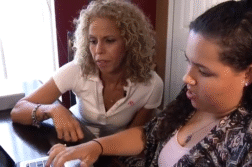NEW ORLEANS, La. (Ivanhoe Newswire) — Navigating your way through any medical issue can be challenging to say the least. Insurance … schedules … confusing and sometimes contradictory orders. Who are we to believe? There is one solution.
Ann Watts will never forget when she heard these three words: “You have cancer.”
“And it’s exactly what people say. It feels like you were punched in the gut, your head starts spinning, you really zone out and i didn’t hear much of what he had to say after that,” explained Watts.
That shock lingered into her next appointment, but this time Ashley Marks was there taking notes.
“Ashley was like this beautiful bridge between my family and everything at this hospital,” Watts continued.
That’s because she serves as a nurse navigator … staying with patients every step of the way. That means setting up appointments, dealing with insurance companies, being with Watts during every treatment, and always being available by phone.
“I had to be readmitted to the hospital three different times. One time I had blood clots in my arm. She came with the doctors and it was three of them standing there, but there was Ashley and I knew it was bad news, but my sweet Ashley was there to help lessen the burden,” shared Watts.
The program is already seeing results. Shorter times between diagnosis and treatment, better adherence to care instructions, and patients saying they feel more confident.
“If you’re a hospital or medical facility you should care because you know that your patients are going to get the best possible care,” shared Ashley Marks, RN, OCN, ONN-GE, CBCN, GYN Oncology Nurse Navigator, Woman’s Hospital Baton Rouge.
And when Watts found out she was cancer free, Marks was right there to celebrate with her.
“I really thought I would do backflips down the hall,” smiled Watts.
Now she hopes other patients can have the same experience.
“I could not have made this journey without Ashley Marks,” stated Watts.
A patient navigation process is required for a hospital to receive special accreditation for cancer care. Woman’s Hospital has expanded the program to pregnancy and weight loss patients.
Contributors to this news report include: Breanna Molloy, Field Producer; Roque Correa, Editor; and Wladimir Moquette, Videographer.
NURSE NAVIGATORS WITH YOU STEP-BY-STEP
REPORT #2708
BACKGROUND: Nurse navigators are becoming extremely important in helping patients “navigate” their way through quality care. They also help in overcoming any barriers to care. According to the Academy of Oncology Nurse & Patient Navigators, “The heart of navigation is personalized care,” which applies to patients, families, and caregivers. Nurse navigators focus on the clinical aspects of care. They are often involved from the point of a suspicious finding through diagnostic testing, treatment, and follow-up or end-of-life care. They respond to questions in a timely manner, explain the rationale behind the planned treatment, and coordinate care. All this goes a long way in reducing a patient’s anxiety and enhancing his or her ability to follow through with appointments and prescribed treatment. There is no one-size-fits-all approach. Providing information specific to the patient’s diagnosis and plan of care not only informs the patient but also helps relieve uncertainty. This allows patients to focus on achieving the best health outcome possible, and on living their lives.
(Source: https://nurse.org/articles/nurse-navigator-career-path-salary-job-description/)
THE LAUNCH OF NAVIGATION PROGRAMS: Wesley Medical Center in Kansas announced it was expanding perinatal nurse navigation services by adding maternity navigation. The program’s services are free and available to any woman. They include providing tours of the hospital, reviewing available hospital amenities, helping create birth plans, and discussing risk or health factors that could affect delivery. University of Alabama at Birmingham (UAB) and Children’s of Alabama announced that an interdisciplinary team was awarded a grant to create the “Family Care Connect Program”. This program uses non-clinical navigators to provide support and services to children diagnosed with cancer and sickle cell disease as well as to their families. And, Providence Health & Services in Washington launched a program that placed patient navigators at three of its San Fernando Valley, Calif., hospitals. These navigators, who come from behavioral healthcare provider Tarzana Treatment Centers, are tasked with helping to screen and enroll homeless individuals experiencing substance abuse and mental health issues into one of Tarzana’s centers.
(Source: http://nursenavigation.com/7-nurse-navigation-patient-navigation-programs-launched-2018/)
NAVIGATORS CONFIRMED ESSENTIAL TEAM MEMBERS: Healthcare barriers such as dollars spent on the management of chronic diseases and disparities among the underserved and low socioeconomic individuals including transportation needs, finances, health literacy, cultural beliefs, and lack of education can be eradicated with the use of a patient navigator. Patient navigators are health professionals such as a nurse, social worker, or lay person trained to help patients navigate the complex healthcare systems of today. Patient navigators assist patients with managing follow-up appointments, medications, transportation needs, and coordination of care. The improvement in access to healthcare for the poor and underserved has improved patient outcomes which have contributed to lower healthcare costs. The positive outcomes of patient satisfaction and lower healthcare costs are an advantage to healthcare systems. These benefits support the need for patient navigators.
* For More Information, Contact:
Caroline Isemann, Public Relations Coordinator
Caroline.Isemann@womans.org / (504) 909-8359
Free weekly e-mail on Medical Breakthroughs from Ivanhoe. To sign up: http://www.ivanhoe.com/ftk



